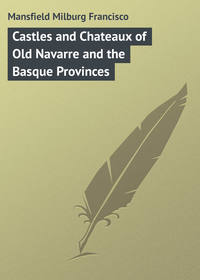 полная версия
полная версияDumas' Paris
“The house was inaccessible on three sides, but the fourth, which did not face the road, abutted on a large sheet of water; and ten feet above its surface were the windows of the refectory.
“This little lake was carefully guarded, and was surrounded by high wooden palisades. A single iron gate opened into it, and at the same time gave a passage to the waters of a small rivulet which fed the lake, and the water had egress at the opposite end.”
From this point on, the action of “The Regent’s Daughter” runs riotously rapid, until it finally culminates, so far as Nantes is concerned, in the quintuple execution before the château, brought about by the five minutes’ delay of Gaston with the reprieve.
Dumas’ knowledge of and love of the Mediterranean was great, and he knew its western shores intimately.
In 1830 he resolved to visit all the shores of the Mediterranean in a yacht, which he had had specially built for the purpose, called the Emma.
He arrived in Sicily, however, at the moment of the Garibaldian struggle against the King of Italy, with the result that the heroic elements of that event so appealed to him, that he forewent the other more tranquil pleasure of continuing his voyage, and went over to the mainland.
In “The Count of Monte Cristo” is given one of Dumas’ best bits of descriptive writing. At any rate, it describes one of the aspects of the brilliantly blue Mediterranean, which is only comparable to one’s personal contemplation of its charms. It is apropos of the voyage to the island of Monte Cristo – which lies between Elba and Corsica, and has become fabled in the minds of present-day readers solely by Dumas’ efforts – that he wrote the following:
“It was about six o’clock in the evening; an opal-coloured light, through which an autumnal sun shed its golden rays, descended on the blue sea. The heat of the day had gradually decreased, and a light breeze arose, seeming like the respiration of nature on awakening from the burning siesta of the south; a delicious zephyr played along the coasts of the Mediterranean, and wafted from shore to shore the sweet perfume of plants, mingled with the fresh smell of the sea.
“A light yacht, chaste and elegant in its form, was gliding amidst the first dews of night over the immense lake, extending from Gibraltar to the Dardanelles, and from Tunis to Venice. The motion resembled that of a swan with its wings opened toward the wind, gliding on the water. It advanced, at the same time, swiftly and gracefully, leaving behind it a glittering track. By degrees the sun disappeared behind the western horizon; but, as though to prove the truth of the fanciful ideas in heathen mythology, its indiscreet rays reappeared on the summit of each wave, seeming to reveal that the god of fire had just enfolded himself in the bosom of Amphitrite, who in vain endeavoured to hide her lover beneath her azure mantle.”
Of the island of Monte Cristo itself, Dumas’ description is equally gratifying. In the earlier chapters he gives it thus:
“The isle of Monte Cristo loomed large in the horizon… They were just abreast of Mareciana, and beyond the flat but verdant isle of La Pianosa. The peak of Monte Cristo, reddened by the burning sun, was seen against the azure sky… About five o’clock in the evening the island was quite distinct, and everything on it was plainly perceptible, owing to that clearness of the atmosphere which is peculiar to the light which the rays of the sun cast at its setting.
“Edmond gazed most earnestly at the mass of rocks which gave out all the variety of twilight colours, from the brightest pink to the deepest blue; and from time to time his cheeks flushed, his brow became purple, and a mist passed over his eyes… In spite of his usual command over himself, Dantès could not restrain his impetuosity. He was the first who jumped on shore; and had he dared, he would, like Lucius Brutus, have ‘kissed his mother earth.’ It was dark, but at eleven o’clock the moon rose in the midst of the ocean, whose every wave she silvered, and then, ‘ascending high,’ played in floods of pale light on the rocky hills of this second Pelion.
“The island was familiar to the crew of La Jeune Amélie– it was one of her halting-places. As to Dantès, he had passed it on his voyages to and from the Levant, but never touched at it.”
It is unquestionable that “The Count of Monte Cristo” is the most popular and the best known of all Dumas’ works. There is a deal of action, of personality and characterization, and, above all, an ever-shifting panorama, which extends from the boulevards of Marseilles to the faubourgs of Paris, and from the island Château d’If to the equally melancholy allées of Père la Chaise, which M. de Villefort, a true Parisian, considered alone worthy of receiving the remains of a Parisian family, as it was there only that they would be surrounded by worthy associates.
All travellers for the East, via the Mediterranean, know well the ancient Phœnician port of Marseilles. One does not need even the words of Dumas to recall its picturesqueness and importance – to-day as in ages past. Still, the opening lines of “The Count of Monte Cristo” do form a word-picture which few have equalled in the pages of romance; and there is not a word too much; nothing superfluous or extraneous.
“On the 28th of February, 1815, the watchtower of Notre Dame de la Garde signalled the three-master, the Pharaon, from Smyrna, Trieste, and Naples.
“As usual, a pilot put off immediately, and, rounding the Château d’If, got on board the vessel between Cape Morgion and the isle of Rion.
“Immediately, and according to custom, the platform of Fort Saint-Jean was covered with lookers-on; it is always an event at Marseilles for a ship to come into port, especially when this ship, like the Pharaon, had been built, rigged, and laden on the stocks of the old Phocée, and belonged to an owner of the city.
“The ship drew on: it had safely passed the strait, which some volcanic shock has made between the isle of Calasareigne and the isle of Jaros; had doubled Pomègue, and approached the harbour under topsails, jib, and foresail, but so slowly and sedately that the idlers, with that instinct which misfortune sends before it, asked one another what misfortune could have happened on board. However, those experienced in navigation saw plainly that, if any accident had occurred, it was not to the vessel herself, for she bore down with all the evidence of being skilfully handled, the anchor ready to be dropped, the bowsprit-shrouds loose, and, beside the pilot, who was steering the Pharaon by the narrow entrance of the port Marseilles, was a young man, who, with activity and vigilant eye, watched every motion of the ship, and repeated each direction of the pilot.
“The vague disquietude which prevailed amongst the spectators had so much affected one of the crowd that he did not await the arrival of the vessel in harbour, but, jumping into a small skiff, desired to be pulled alongside the Pharaon, which he reached as she rounded the creek of La Réserve.”
The process of coming into harbour at Marseilles does not differ greatly to-day from the description given by Dumas.
New harbour works have been constructed, and sailing-ships have mostly given way to great steamers, but the channel winds and twists as of old under the lofty brow, capped by the sailors’ church of Notre Dame de la Garde, which is to-day a tawdry, bizarre shrine, as compared with the motive which inspired the devout to ascend its heights to pray for those who go down to the sea in ships.
Marseilles, of all cities of France, more even than Bordeaux or Lyons, is possessed of that individuality which stands out strong on the background of France – the land and the nation.
In the commercial world its importance gives it a high rank, and its affaires are regulated by no clues sent each morning by post or by telegraph from the world’s other marts of trade. It has, moreover, in the Canebière, one of the truly great streets of the world. Dumas remarked it, and so, too, have many others, who know its gay cosmopolitan aspect at all the hours of day and night.
From “The Count of Monte Cristo,” the following lines describe it justly and truly, and in a way that fits it admirably, in spite of the fact that Dumas wrote of it as it was a hundred years ago:
“The young sailor jumped into the skiff, and sat down in the stern, desiring to be put ashore at the Canebière. The two rowers bent to their work, and the little boat glided away as rapidly as possible in the midst of the thousand vessels which choke up the narrow way which leads between the two rows of ships from the mouth of the harbour to the Quai d’Orléans.
“The ship-owner, smiling, followed him with his eyes until he saw him spring out on the quai and disappear in the midst of the throng, which, from five o’clock in the morning until nine o’clock at night, choke up this famous street of La Canebière, of which the modern Phocéens are so proud, and say, with all the gravity in the world, and with that accent which gives so much character to what is said, ‘If Paris had La Canebière, Paris would be a second Marseilles.’”
The Château d’If, far more than the island of Monte Cristo itself, is the locale which is mostly recalled with regard to the romance of “Monte Cristo.”
Dumas has, of course, made melodramatic use of it; in fact, it seems almost as if he had built the romance around its own restricted pied à terre, but, nevertheless, it is the one element which we are pleased to call up as representative of the story when mention is made thereof.
Not a line, not a word, is misplaced in the chapters in which Dumas treats of Dantès’ incarceration in his island prison. Description does not crowd upon action or characterization, nor the reverse.
“Through the grating of the window of the carriage, Dantès saw they were passing through the Rue Caisserie, and by the Quai St. Laurent and the Rue Taramis, to the port. They advanced toward a boat which a custom-house officer held by a chain near the quai. A shove sent the boat adrift, and the oarsman plied it rapidly toward the Pilon. At a shout the chain that closes the port was lowered, and in a second they were outside the harbour… They had passed the Tête de More, and were now in front of the lighthouse and about to double the battery… They had left the isle Ratonneau, where the lighthouse stood, on the right, and were now opposite the Point des Catalans.
“‘Tell me where you are conducting me?’ asked Dantès of his guard.
“‘You are a native of Marseilles, and a sailor, and yet you do not know where you are going?’
“‘On my honour, I have no idea.’
“‘That is impossible.’
“‘I swear to you it is true. Tell me, I entreat.’
“‘But my orders.’
“‘Your orders do not forbid your telling me what I must know in ten minutes, in half an hour, or an hour. You see, I cannot escape, even if I intended.’
“‘Unless you are blind, or have never been outside the harbour, you must know.’
“‘I do not.’
“‘Look around you, then.’ Dantès rose and looked forward, when he saw rise within a hundred yards of him the black and frowning rock on which stands the Château d’If. This gloomy fortress, which has for more than three hundred years furnished food for so many wild legends, seemed to Dantès like a scaffold to a malefactor.
“‘The Château d’If?’ cried he. ‘What are we going there for?’ The gendarme smiled.
“‘I am not going there to be imprisoned,’ said Dantès; ‘it is only used for political prisoners. I have committed no crime. Are there any magistrates or judges at the Château d’If?’
“‘There are only,’ said the gendarme, ‘a governor, a garrison, turnkeys, and good thick walls. Come, come, do not look so astonished, or you will make me think you are laughing at me in return for my good nature.’ Dantès pressed the gendarme’s hand as though he would crush it.
“‘You think, then,’ said he, ‘that I am conducted to the château to be imprisoned there?’
“‘It is probable.’”
The details of Dantès’ horrible confinement, at first in an upper cell, and later in a lower dungeon, where, as “No. 34,” he became the neighbour of the old Abbé Faria, “No. 27,” are well known of all lovers of Dumas. The author does not weary one, and there are no lengthy descriptions dragged in to merely fill space. When Dantès finally escapes from the château, after he had been imprisoned for fourteen years, Dumas again launches into that concise, direct word-painting which proclaims him the master.
“It was necessary for Dantès to strike out to sea. Ratonneau and Pomègue are the nearest isles of all those that surround the Château d’If; but Ratonneau and Pomègue are inhabited, together with the islet of Daume; Tiboulen or Lemaire were the most secure. The isles of Tiboulen and Lemaire are a league from the Château d’If…
“Before him rose a mass of strangely formed rocks, that resembled nothing so much as a vast fire petrified at the moment of its most fervent combustion. It was the isle of Tiboulen…
“As he rose, a flash of lightning, that seemed as if the whole of the heavens were opened, illumined the darkness. By its light, he saw the isle of Lemaire and Cape Croiselle, a quarter of a league distant.”
In “The Count of Monte Cristo,” Dumas makes a little journey up the valley of the Rhône into Provence.
In the chapter entitled “The Auberge of the Pont du Gard,” he writes, in manner unmistakably familiar, of this land of the troubadours, the roses, and the beautiful women; for the women of Arles – those world-famous Arlesiennes – are the peers, in looks, of all the women of France.
Dumas writes of Beaucaire, of Bellegarde, of Arles, and of Aigues-Mortes, but not very affectionately; indeed, he seems to think all Provence “an arid, sterile lake,” but he comes out strong on the beauty of the women of Arles, and marvels how they can live in the vicinity of the devastating fevers of the Camargue.
The auberge of the Pont du Garde itself – the establishment kept by the old tailor, Caderousse, whom Dantès sought out after his escape from the Château d’If – the author describes thus:
“Such of my readers as have made a pedestrian excursion to the south of France may perchance have noticed, midway between the town of Beaucaire and the village of Bellegarde, a small roadside inn, from the front of which hung, creaking and flapping in the wind, a sheet of tin covered with a caricature resemblance of the Pont du Gard. This modern place of entertainment stood on the left-hand side of the grand route, turning its back upon the Rhône. It also boasted of what in Languedoc is styled a garden, consisting of a small plot of ground, a full view of which might be obtained from a door immediately opposite the grand portal by which travellers were ushered in to partake of the hospitality of mine host of the Pont du Gard. This plaisance or garden, scorched up beneath the ardent sun of a latitude of thirty degrees, permitted nothing to thrive or scarcely live in its arid soil. A few dingy olives and stunted fig-trees struggled hard for existence, but their withered, dusty foliage abundantly proved how unequal was the conflict. Between these sickly shrubs grew a scanty supply of garlic, tomatoes, and eschalots; while, lone and solitary, like a forgotten sentinel, a tall pine raised its melancholy head in one of the corners of this unattractive spot, and displayed its flexible stem and fan-shaped summit dried and cracked by the withering influence of the mistral, that scourge of Provence.”
The great fair of Beaucaire was, and is, – though Beaucaire has become a decrepit, tumble-down river town on the Rhône, with a ruined castle as its chief attraction, – renowned throughout France.
It was here that the head of the house of Morrel, fearing lest the report of his financial distress should get bruited abroad at Marseilles, came to sell his wife’s and daughter’s jewels, and a portion of his plate.
This fair of Beaucaire attracted a great number of merchants of all branches of trade, who arrived by water and by road, lining the banks of the Rhône from Arles to Beaucaire, and its transpontine neighbour, Tarascon, which Daudet has made famous.
Caderousse, the innkeeper, visited this fair, as we learn, “in company with a man who was evidently a stranger to the south of France; one of those merchants who come to sell jewelry at the fair of Beaucaire, and who, during the month the fair lasts, and during which there is so great an influx of merchants and customers from all parts of Europe, often have dealings to the amount of one hundred thousand to one hundred and fifty thousand francs (£4,000 to £6,000).”
That Dumas was a great traveller is well known and substantiated by the records he has left.
When living at Toulon in the spring of 1835, as he himself tells us, he first came into possession of the facts which led to the construction of “Gabriel Lambert.”
There was doubtless much of truth in the tale, which appears not to be generally known to English readers, and it is more than probable that much of the incident was originally related to Dumas by the “governor of the port.”
Dumas was living at the time in a “small suburban house,” within a stone’s throw of Fort Lamalge, the prison, hard at work on his play of “Captain Paul” – though, as he says, he was greatly abstracted from work by the “contemplation of the blue Mediterranean spangled with gold, the mountains that blind in their awful nakedness, and of the sky impressive in its depth and clearness.”
The result of it all was that, instead of working at “Captain Paul” (Paul Jones), he left off working at all, in the daytime, – no infrequent occurrence among authors, – and, through his acquaintance with the governor, evolved the story of the life-history of “Gabriel Lambert.”
“Murat” was the single-worded title given by Dumas to what is perhaps the most subtle of the “Crimes Célèbres.” He drew his figures, of course, from history, and from a comparatively near view-point, considering that but twenty-five years had elapsed since the death of his subject.
Marseilles, Provence, Hyères, Toulon, and others of those charming towns and cities of the Mediterranean shore, including also Corsica, form the rapid itinerary of the first pages.
For the action itself, it resembles nothing which has gone before, or which is so very horrible. It simply recounts the adventures and incidents in the life of the Marshal of France which befel his later years, and which culminated in his decapitated head being brought before the King of Naples as the only assurance which would satisfy him that Murat was not an adventurer and intriguer.
There is a pleasant little town in the Midi of France by the name of Cahors. It is a historic town as well; in fact, it was part of the dowry which Henri de Navarre was to receive when he married Marguerite.
The circumstance is recounted by Dumas in “The Forty-Five Guardsmen,” and extends to some length in the most marvellously descriptive dialogue.
“The poor Henri de Navarre,” as Dumas called him, “was to receive as his wife’s dowry three hundred thousand golden crowns and some towns, among them Cahors.
“‘A pretty town, mordieu!’
“‘I have claimed not the money, but Cahors.’
“‘You would much like to hold Cahors, Sire?’
“‘Doubtless; for, after all, what is my principality of Béarn? A poor little place, clipped by the avarice of my mother-in-law and brother-in-law.’
“‘While Cahors – ’
“‘Cahors would be my rampart, the safeguard of my religion.’
“‘Well, Sire, go into mourning for Cahors; for, whether you break with Madame Marguerite or not, the King of France will never give it to you, and unless you take it – ’
“‘Oh, I would soon take it, if it was not so strong, and, above all, if I did not hate war.’
“‘Cahors is impregnable, Sire.’
“‘Oh! impregnable! But if I had an army, which I have not – ’
“‘Listen, Sire. We are not here to flatter each other. To take Cahors, which is held by M. de Vezin, one must be a Hannibal or a Cæsar; and your Majesty – ’
“‘Well?’ said Henri, with a smile.
“‘Has just said you do not like war.’…
“‘Cahors is so well guarded, because it is the key of the south.’”
Chapter fifty-three of the above book recounts the siege itself, – as we know it in history, – but with all that added picturesqueness which Dumas commanded.
“‘Henri will not pay me his sister’s dowry, and Margot cries out for her dear Cahors. One must do what one’s wife wants, for peace’s sake; therefore I am going to try to take Cahors.’…
“Henri set off at full gallop, and Chicot followed him. On arriving in front of his little army, Henri raised his visor, and cried:
“‘Out with the banner! out with the new banner!’
“They drew forth the banner, which had the double scutcheon of Navarre and Bourbon; it was white, and had chains of gold on one side, and fleurs-de-lis on the other.
“Again the cannon from Cahors were fired, and the balls tore through a file of infantry near the king…
“‘Oh!’ cried M. de Turenne, ‘the siege of the city is over, Vezin.’ And as he spoke he fired at him and wounded him in the arm…
“‘You are wrong, Turenne,’ cried M. de Vezin; ‘there are twenty sieges in Cahors; so, if one is over, there are nineteen to come.’
“M. de Vezin defended himself during five days and nights from street to street and from house to house. Luckily for the rising fortunes of Henri of Navarre, he had counted too much on the walls and garrison of Cahors, and had neglected to send to M. de Biron…
“During these five days and nights, Henri commanded like a captain and fought like a soldier, slept with his head on a stone, and awoke sword in hand. Each day they conquered a street or a square, which each night the garrison tried to retake. On the fourth night the enemy seemed willing to give some rest to the Protestant army. Then it was Henri who attacked in his turn. He forced an intrenched position, but it cost him seven hundred men. M. de Turenne and nearly all the officers were wounded, but the king remained untouched.”
The Pyrenean city of Pau is more than once referred to by Dumas in the Valois romances, as was but natural, considering that its ancient château was the berceau of that Prince of Béarn who later married the intriguing Marguerite, and became ultimately Henri IV.
This fine old structure – almost the only really splendid historical monument of the city – had for long been the residence of the Kings of Navarre; was rebuilt in the fourteenth century by the brilliant Gaston Phœbus; and enlarged and luxuriously embellished by the beautiful Marguerite herself in the sixteenth century, after she had become la femme de Henri d’Albert, as her spouse was then known.
As might be expected, Dumas was exceedingly familiar with the suburban topography of Paris, and made frequent use of it in his novels.
It is in “The Count of Monte Cristo,” however, that this intimacy is best shown; possibly for the reason that therein he dealt with times less remote than those of the court romances of the “Valois” and the “Capets.”
When Dantès comes to Paris, – as the newly made count, – he forthwith desires to be ensconced in an establishment of his own. Dumas recounts the incident thus:
“‘And the cards I ordered to be engraved as soon as you knew the number of the house?’
“‘M. le Comte, it is done already. I have been myself to the best engraver of the Palais Royal, who did the plate in my presence. The first card struck off was taken, according to your orders, to M. le Baron Danglars, Rue de la Chaussée d’Antin, No. 7.’…
“As the steward had said, the notary awaited him in the small salon. He was a simple-looking lawyer’s clerk, elevated to the extraordinary dignity of a provincial scrivener.
“‘You are the notary empowered to sell the country-house that I wish to purchase, monsieur?’ asked Monte Cristo.
“‘Yes, M. le Comte,’ returned the notary.
“‘Is the deed of sale ready?’
“‘Yes, M. le Comte.’
“‘Have you brought it?’
“‘Here it is.’
“‘Very well; and where is this house that I purchase?’ asked the count, carelessly, addressing himself half to Bertuccio, half to the notary. The steward made a gesture that signified, ‘I do not know.’ The notary looked at the count with astonishment.
“‘What!’ said he, ‘does not M. le Comte know where the house he purchases is situated?’









